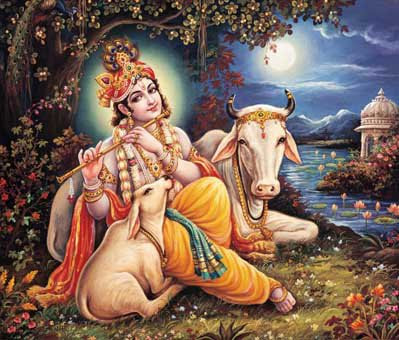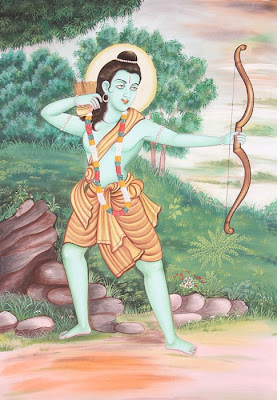(Vyasar Ganesan was born in Derry, New Hampshire, and raised in Austin. His mother is from near Delhi, and his father comes from southern India. He currently is an arts graduate of Allegheny College, having just finished a senior project in creative nonfiction. Vyasar is a blogger for Radha Madhav Dham, the main US ashram of Jagadguru Shree Kripaluji Maharaj.)

6/3/12 Austin, TX 3:43 PM
Living in Texas, it's hard to ignore the prevalence of cows. Cattle farms, dairy farms, along the highway and in the supermarket, the cow is virtually the symbol of the state. If there were traffic jams caused by livestock here, people might think they'd somehow ended up in India. The primacy of the bovine is acknowledged, but not understood. This week's misconception, therefore, is the nature of cows in Sanatan Dharm.
"Why do you worship cows?" This question echoes from California to New England, one of the universal puzzlements Americans suffer from. Really though, they should be asking themselves that question. More than just Texas, the whole country is fanatically addicted to the animal. Specialty cheeses, milk of all kinds and colors; we live in an age where milk is an industrial commodity, rather than an agricultural one.
Milk is just as important, if not more so, to Indians as it is to Americans. We use it so much, for so many things, that the respect for the product carries over to affection for the source. Cows are the lifeblood of many small communities, and the size of a herd can indicate a great deal about the status or health of villages in India. We use ghee (clarified butter) and milk in ceremonies, and we revere the cow for providing it. We drink the cow's milk, as though it were our mother's. So indeed, we respect the cow as if it were our mother.
However, the question about 'worshipping cows' is based on misinformation. Hindus do not 'worship,' cows, in the implied sense of the word. There is a religious relationship between us, but it is not one of worship. In its place, there is a deep reverence for life in all forms.
When someone dies, their soul is reincarnated throughout the 8.4 million species, based on their karm. So, at any given time, the animals, insects and bacteria you see around you are all souls, waiting for their chance to be reborn as humans. Sanatan Dharm's perspective on all of the life that teems around us, waiting for its chance at God realization, certainly breeds a loving amount of respect for all creation.
Finally, during Krishn's avatar on Earth, he cultivated an incredibly strong bond with cows. There are many leelas of Krishn in Braj, playing with the cows, tending to them every day. Revering and respecting cows is important from a devotional perspective, too. When we look at cows today, with their gentleness and calm manner, it is the beginning of a connection to the past, when Krishn played his flute and all of nature fell under its irresistibly soothing spell. We can feel our own lives slow down to match the simple pace of the cow, sitting on a grassy hill to watch the sunset, some clover between our teeth and a little more love in our hearts.






















